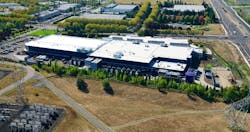5 Keys to Success in Data Center Site Selection
A new special report series, courtesy of Stack Infrastructure, kicks off with highlighting one of the keys to successful data center site selection: knowing your surroundings. A data center is a long-term investment, and choosing a location requires being sensitive both the needs of the business and the surrounding community.
Get the full report.
As the data center industry experiences powerful growth, the need to find the perfect site and deploy capacity quickly has never been greater. Site selection brings together financial
modeling, community relations, engineering design, construction planning, and even a little fortune telling to deploy capacity where digital businesses need it.
The choice of site needs to take into account a wide variety of factors, not all of which are intuitive. A data center is a long-term investment, and choosing a location requires being sensitive both the needs of the business and the surrounding community.
As you begin your journey toward siting a new data center, follow these five rules of the road.
Rule One: Know Your Surroundings
More than one-third of companies estimate that server downtime costs more than $1 million per hour, and 15% estimate the toll at greater than $5 million. Data centers are subject to the same forces of nature as any building, but the impact of a devastating loss is potentially much greater. Physical resilience is important, but so disaster response. Take the following factors into account.
Climate
The incidence of high temperatures, record precipitation and damaging storms has been rising for several years due to climate change. The impact of climactic forces goes beyond the wind and rain damage of a storm event. Hurricane Harvey, which slammed into the Texas coast in 2017, produced storm surges of up to 12 feet. The Mississippi River was at flood levels for nearly three months following heavy rains in 2019. Areas that were once considered safe may not be as secure years in the future.
Climate can also influence surrounding areas in a way that affects the data center. For example, heat waves can cause brownouts that force data center operators to rely on backup generators. Blackouts caused by hurricanes and tornadoes can have the same effect. Extreme weather may also influence the ability of critical employees to get to work. Site selection needs to anticipate these factors and put appropriate backups and redundancies in place.
Seismic Activity
While the west coast of the U.S. is known to be at high risk of earthquakes, pockets of frequent seismic activity exist all across North America.
In fact, two of the most seismically active areas of the U.S. are Missouri and South Carolina. Parts of the southeast, northeast and northern Rocky Mountains are also shaken on a regular basis.
Seismic activity can be quite localized. For example, the U.S. Geological Survey estimates the likelihood of a magnitude 7 earthquake striking the San Francisco Bay area during the next 30 years at 51% but Sacramento, which is less than a 90-minute drive away, is considered one of the least vulnerable areas of the state. Seismic events can cause disruptions other than property damage, including power loss, water line ruptures and damage to roads and bridges. Site selection needs to incorporate risk analysis and appropriate failover strategies.
When selecting a site for a hyperscale facility, obey these five rules of the road to keep your business and the surrounding community in perfect harmony.
Accessibility
Constructing and equipping a data center involves moving lots of heavy-duty equipment. The condition of nearby roads can be a significant factor in ensuring safe and efficient transportation. Data center operators should also consider the ease of moving people, especially during an emergency. Accessibility is a classic “last mile” issue. The U.S. National Highway System accounts for only about 4% of the nation’s total public road miles. The area of greatest risk are the access roads to the data center site. The facility should be safely accessible by multiple routes. Owners should also consider proximity to airports and rail transport, keeping in mind that rail lines and aircraft approach patterns can also be hazards.
Talent
Often overlooked in the siting decision is the importance of having the right skills in the area. The importance of talent varies with the needs and uses of the facility, ranging from basic hardware maintenance, network and system administration to facilities and operations management. Uptime Institute’s 2018 global survey of data center operators found that more than half said they were either having difficulty finding or retaining data center staff.
Urban centers with a concentration of large businesses and academic institutions provide the best access to technical talent, but at the highest prices. Low-cost regions may be a good option for data center owners that can affordably relocate employees or that run primarily “lights out” operations.
Over the coming weeks, the special report series will also explore the following topics in relation to data center site selection: the value of knowing the grid, the network and your local stakeholders.
Get the new special report, “Five Things To Know About Data Center Site Selection,” to learn more about how to successfully approach the data center site selection process.





